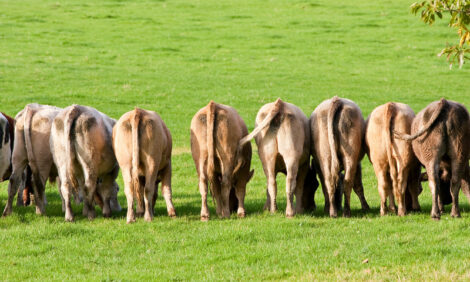



Careful Feeding Can Reduce Livestock Emissions
UK - Greenhouse gas emissions from livestock can by cut by up to 15 per cent by careful management of the grass they graze, according to EBLEX, the English beef and lamb levy board.Excess wind is a by-product of rumination and methane is among the contributors to global emissions that the industry has been challenged with cutting by 11 per cent by 2020.
EBLEX researchers looking at how producers can make efficiency improvements on farm - which go hand in hand with economic improvements - through the use of improved grass varieties for nutrient use efficiency and alternative forages that supply high quality feed and thrive in drier conditions.
"Feeds low in indigestible fibre, like high quality grass, lead to less methane being produced in the rumen and, therefore, burped out," said Dr Duncan Pullar, EBLEX Head of Research and Development.
"So by spending greater attention on selecting grass types and ensuring grasslands are properly managed helps to cut emissions.
"Permanent pasture is an important part of the production of beef and sheep meat but the potential to reduce emissions purely by using new varieties is limited so there is a massive focus on improving grassland management, in particular sward height targets and maintaining soil fertility.
"At this time of year, realistically, average cattle weight gain on grass is half a kilo a day. We know from our work that 1.2kg a day from grass is achievable, so there is significant scope for improvement and that is down to managing grass as a resource."
Another important aspect to remember is that feeds other than grass may need to be used, especially in winter, so the animal's requirements are met. In the UK, around 80 per cent of the energy in beef diets is from grass and 90 per cent of the energy for sheep diets. To make up the shortfall and when grass is not plentiful, correct rationing with other feeds is needed to ensure performance is not limited, especially during late pregnancy in ewes or when finishing cattle.
"We continue to work proactively to look at what beef and sheep producers can do to improve their environmental performance and correct management of pastures is vital," added Mr Puller.
"If we take an average pasture and focus on its management, and increase the amount of clover, for example, this can lead to a 15 per cent reduction in global warming potential (GWP) per kilo of carcase in cattle, and a 10 per cent reduction in sheep.
"Reducing greenhouse gas emissions is a challenge for all sectors of industry. In the livestock sector, we take the challenges seriously and have an ongoing programme of research and knowledge transfer to look into cost effective, practical ways individual farmers can make an impact."
| TheCattleSite News Desk | Read more EBLEX News here |


